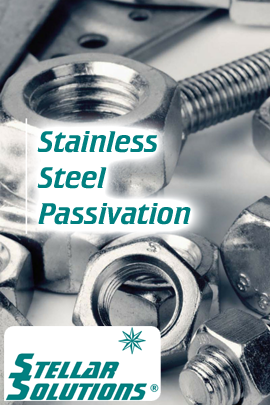What is Passivation? How to Passivate Stainless Steel, and Why.
Why is it necessary to passivate stainless steel?
Stainless steel is a naturally corrosion resistant alloy. The primary component of stainless steel which provides corrosion resistance is chromium, which in the presence of oxygen forms a corrosion-resistant (a.k.a. passive) layer on the surface of the stainless steel. This chromium oxide layer protects the metal below it from interacting with the environment around it to form corrosion. While the chromium typically present on the surface will naturally create a passive layer, there is a significant amount of iron inherent to the alloy (about 60-70%, depending on the grade of stainless) which limits the corrosion resistance. It is also common for additional iron contamination to be introduced to the surface during manufacturing processes, such as via iron dust in the shop air or contact with carbon steel tools, which further decreases corrosion resistance. The solution to these issues is the passivation process.
What is passivation?
What is the definition of passivation? Simply put, passivation is the intentional removal of iron from the stainless steel surface and there are different passivation types. Removal of surface iron and iron contamination results in a stainless steel surface that is low in iron and high in chromium. With more chromium at the surface a thicker chromium oxide layer can be achieved, which results in significantly improved corrosion resistance due to lack of iron available to react with the environment.
How can I passivate stainless steel safely and economically?
 Passivation of stainless steel can be performed using nitric acid or citric acid. However, there are many reasons that it is better to use citric acid. Many tests have shown that citric acid passivation is more effective than nitric because it only removes iron while leaving all of the chromium, nickel, and other “good” components intact. By contrast, nitric acid will also remove some chromium and nickel along with the iron. Citric acid passivation is also much safer and better for the environment. Nitric acid is extremely toxic to humans, animals and the environment. For anyone who considers worker safety to be of paramount importance, citric acid passivation is the obvious choice.
Passivation of stainless steel can be performed using nitric acid or citric acid. However, there are many reasons that it is better to use citric acid. Many tests have shown that citric acid passivation is more effective than nitric because it only removes iron while leaving all of the chromium, nickel, and other “good” components intact. By contrast, nitric acid will also remove some chromium and nickel along with the iron. Citric acid passivation is also much safer and better for the environment. Nitric acid is extremely toxic to humans, animals and the environment. For anyone who considers worker safety to be of paramount importance, citric acid passivation is the obvious choice.
CitriSurf for Passivation of Stainless Steel
We manufacture and sell a full line of Citrisurf® products for passivation of stainless steel. Passivating stainless steel with CitriSurf is safe, easy, economical, and environmentally friendly. Contact us today for a product recommendation that is tailored to your particular application, or view our product list.
What about metals other than stainless steel?
This depends a lot on the particular context. Some other surface treatments or coatings designed to prevent corrosion or degradation of other materials are also sometimes referred to as “passivation”. Also, removal of surface iron contamination from alloys that otherwise contain little to no iron, using the same process as that for stainless steel, is generally called passivation.

